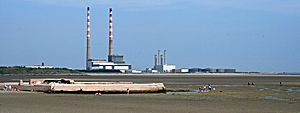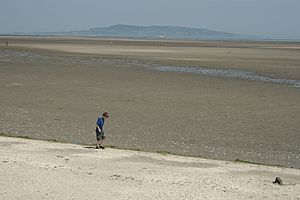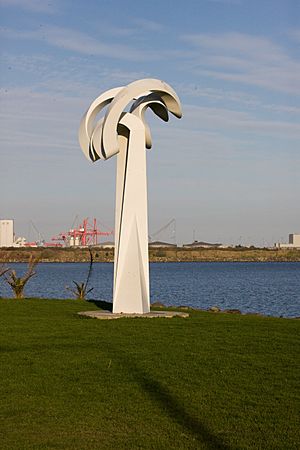Sandymount Strand facts for kids
Quick facts for kids
Designations
|
|
| Official name: Sandymount Strand/Tolka Estuary | |
| Designated: | 7 June 1996 |
|---|---|
| Reference #: | 832 |
Sandymount Strand (which is Dumhach Thrá in Irish) is a really big beach on the east coast of Ireland. It's right next to the village of Sandymount in Dublin. This strand is a key part of the south side of Dublin Bay and belongs to the special Dublin Bay Biosphere Reserve.
Sandymount Strand is a super popular spot for local people to go for a walk. Sometimes, people can get caught by the incoming tide if they aren't careful. There's a large pool of water that stays even when the tide is out, and locals call it "Cockle Lake".
Contents
Exploring Sandymount Strand
This section will tell you more about the history and interesting features you can find at Sandymount Strand.
Fun Facts and History
Back in the 1930s, people thought about building a new airport for Dublin right here on the strand! Luckily, that didn't happen, and we still have this beautiful beach to enjoy.
The Old Swimming Baths

In 1883, a company built the Sandymount swimming baths. They were about 40 by 40 metres in size. A year later, in 1884, a 75-metre pier was added. This pier even had a bandstand where summer concerts were held!
Sadly, by 1920, the pier was in bad shape and had to be taken down. But the strong concrete part of the baths, which looks a bit like a small harbor, is still there today.
The Martello Tower Mystery
About halfway along the strand, you'll find a Martello tower. These towers were built way back in 1804. Their job was to warn people if Napoleon was planning to invade!
This specific tower has had a few different lives. It was once an office for a tram company. In the 1960s, it was a popular cafe where people could grab a snack. Someone even tried to turn it into a restaurant, adding a big window facing the sea. But the restaurant never opened, so the tower still has that unique window.
A Gift from Mexico: Awaiting the Mariner
At the end of the strand walkway, there's a tall, 20-foot metal sculpture. It was given to Ireland by the Mexican President, Vicente Fox, in 2002. This sculpture is a symbol of the friendship between the people of Ireland and Mexico.
The artwork is called Awaiting the Mariner (or An Cailín Bán in Irish). It was created by a Mexican artist named Sebastián. When it was first put up, some local people had different opinions about it.
The Sun Stone: Gallan Gréine
You can find the Gallan Gréine marker stone at the end of the strand, near the Irishtown playing fields. This stone was carved by Cliodna Cussen and was dedicated to the famous writer James Joyce in 1983.
There's another stone about 300 metres to the west. When you line up these two stones, they show you where the sun rises during the winter solstice (around December 21st each year) over Killiney Hill. The front of the Gallan Gréine stone also works as a sundial!



